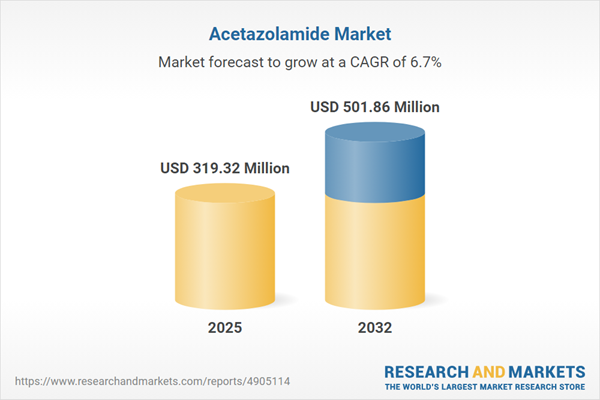Speak directly to the analyst to clarify any post sales queries you may have.
The acetazolamide market is seeing strategic evolution as pharmaceutical manufacturers and supply networks address rising clinical demand, changing regulations, and the pursuit of new delivery methods. Senior leaders who integrate insight and agility can realize differentiated value in this dynamic therapeutic space.
Market Snapshot: Acetazolamide Market Size and Growth
The acetazolamide market expanded from USD 299.50 million in 2024 to USD 319.32 million in 2025 and is anticipated to grow at a CAGR of 6.66%, reaching USD 501.86 million by 2032. This momentum stems from elevated adoption in neurological and ophthalmic care, alongside broader use in patient-centric delivery systems and favorable regulatory trends across major geographies. Growth is also reinforced by pharmaceutical innovation and adaptable supply strategies, which help stakeholders capture new value amid shifting healthcare priorities.
Scope & Segmentation
- Type: Branded and generic formulations are available, supporting healthcare sites seeking varied pricing structures and therapeutic profiles.
- Dosage Form: Tablet and injectable products provide practical solutions for both immediate intervention and chronic management needs in diverse care settings.
- Application: Utilization spans altitude sickness, edema related to diuretics, epilepsy, and glaucoma, emphasizing acetazolamide’s role in multiple therapeutic pathways.
- Distribution Channel: Hospital pharmacies, online platforms, and retail pharmacies offer distinct supply chain and patient access strategies, addressing different procurement and fulfillment models.
- End-User: Ambulatory surgical centers, homecare settings, and hospitals/clinics benefit from flexible product deployment, improving the reach and efficiency of clinical interventions.
- Region: Detailed analysis covers the Americas (including the US, Canada, Mexico, Brazil, Argentina, Chile, Colombia, and Peru), EMEA (featuring key countries in Europe, Middle East, and Africa), and Asia-Pacific (comprising China, India, Japan, Australia, South Korea, and Southeast Asian markets), illustrating diverse market drivers across each territory.
- Companies Covered: Assessment of leading companies such as Teva Pharmaceutical Industries, Sandoz, Viatris, Sun Pharma, Dr. Reddy’s, Lupin, Aurobindo, Cipla, Hikma, and Pfizer reveals a broad mix of strategies, innovation cycles, and partnership models that shape competition and market access.
Key Takeaways for Senior Leaders
- Acetazolamide is increasingly included in multidisciplinary treatment protocols as stakeholders prioritize versatile dosing and patient-centric delivery solutions for better clinical outcomes.
- Strengthening supply chain resilience through collaboration with active pharmaceutical ingredient suppliers and manufacturers is central to reducing risks from regulatory and geopolitical disruptions.
- Adoption of sustainable manufacturing practices, including localized production and green chemistry initiatives, addresses both environmental policies and supply reliability objectives.
- Integration of digital health technologies is enhancing therapy management, promoting remote monitoring, and supporting responsive dose adjustments, particularly for chronic and high-risk patients.
- Synergies between academia and industry are advancing the pipeline for new indications and combination therapies, expanding acetazolamide’s clinical impact beyond its current indications.
- The market’s competitive environment is shaped by branded solutions focused on service differentiation, along with generics emphasizing accessible pricing and scalability.
Tariff Impact: Navigating Policy-Driven Cost Dynamics
Upcoming changes to United States tariff policies in 2025 are set to introduce uncertainty regarding the sourcing costs of active pharmaceutical ingredients. Proactive actions include securing alternative or domestic supply sources, revisiting pricing frameworks, and advocating for tariff exemptions through industry channels. Cross-sector collaboration and greater inventory visibility are vital to sustaining cost management and ensuring delivery continuity in this environment.
Methodology & Data Sources
A mixed-methods approach supports this analysis. Quantitative data from regulatory filings, industry reports, and public disclosures are combined with qualitative insights from clinicians, senior executives, and procurement leaders. Findings are validated through targeted case studies and expert workshops, ensuring the reliability and practical engagement of all recommendations.
Why This Report Matters
- Senior decision-makers gain clarity on how evolving regulations and technology trends affect segmentation and growth opportunities in every major region.
- Actionable guidance is provided on formulation innovation, supplier resilience, and partnership approaches that are specific to the acetazolamide market landscape.
- This report supports informed investment, R&D, and procurement strategies through a clear view of payer expectations and regulatory developments.
Conclusion
Success in the acetazolamide market requires adaptability, data-driven decision-making, and collaborative strategies. Stakeholders equipped with timely insights are well positioned to advance organizational objectives and leverage emerging opportunities.
Additional Product Information:
- Purchase of this report includes 1 year online access with quarterly updates.
- This report can be updated on request. Please contact our Customer Experience team using the Ask a Question widget on our website.
Table of Contents
3. Executive Summary
4. Market Overview
7. Cumulative Impact of Artificial Intelligence 2025
List of Figures
Samples

LOADING...
Companies Mentioned
The key companies profiled in this Acetazolamide market report include:- Teva Pharmaceutical Industries Ltd
- Sandoz International GmbH
- Viatris Inc.
- Sun Pharmaceutical Industries Ltd
- Dr. Reddy’s Laboratories Ltd
- Lupin Ltd
- Aurobindo Pharma Ltd
- Cipla Ltd
- Hikma Pharmaceuticals PLC
- Pfizer Inc.
Table Information
| Report Attribute | Details |
|---|---|
| No. of Pages | 198 |
| Published | October 2025 |
| Forecast Period | 2025 - 2032 |
| Estimated Market Value ( USD | $ 319.32 Million |
| Forecasted Market Value ( USD | $ 501.86 Million |
| Compound Annual Growth Rate | 6.6% |
| Regions Covered | Global |
| No. of Companies Mentioned | 11 |









